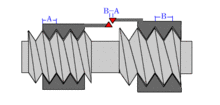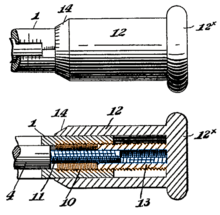Differential screw



%2C_by_Joshua_Rose%2C_Figure_417%2C_1887_-_illo0135e.png)
A differential screw is a mechanism used for making small, precise adjustments to the spacing between two objects (such as in focusing a microscope,[2] moving the anvils of a micrometer,[3][4] or positioning optics[5]). A differential screw uses a spindle with two screw threads of differing leads (aka thread pitch), and possibly opposite handedness, on which two nuts move. As the spindle rotates, the space between the nuts changes based on the difference between the threads. These mechanisms allow extremely small adjustments using commonly available screws. A differential screw mechanism using two nuts incurs higher friction and therefore requires more torque to turn than a simple, single lead screw with an equivalent pitch.[6][7][8]
Examples
Many differential screw configurations are possible. The micrometer adjuster pictured uses a nut sleeve with different inner and outer thread pitches to connect a screw on the adjusting rod end with threads inside the main barrel; as the thimble rotates the nut sleeve, the rod and barrel move relative to each other based on the differential between the threads.
Another arrangement holds the two "nuts" co-axially in a single fixture and has two separate screws with slightly different pitches (length between threads) entering from opposite ends. The "heads" of the screws are fixed to the two objects whose spacing is to be adjusted. Each rotation of the fixture holding the nuts moves one screw into its nut by a small amount and moves the other screw out of its nut by a slightly larger amount. The total spacing between the screws, and thus the objects, will be slightly changed based on the difference in travel between the two screws.
More arrangements are possible. Two nuts can be fixed to each of two objects to be adjusted and the two screw heads attached to each other in the middle. The combined screws would be turned to adjust the spacing in that case.[1]
Calculating motion and effective thread pitch
For single start threads, each turn changes the distance between the nuts by the effective pitch, Peff. For a bolt with a given thread per inch, TPI1 on one end and a second thread per inch, TPI2 on the other, the change in distance (or Peff), and the effective thread per inch TPIeff , is calculated by:
1/TPI1 - 1/TPI2 = 1/TPIeff = Peff [9]
For example, a bolt with coarse threads (16 tpi, 0.0625 in [1.59 mm] per turn) on one end and fine threads (24 tpi, 0.0416 in [1.06 mm] per turn) on the other changes the distance between the nuts by about 0.02 inches (0.51 mm) per revolution and is equivalent to a 48 tpi (0.53 mm/thread) thread:
1/16 - 1/24 = 0.0208 in. (48 tpi, 0.53 mm/thread)
References
- 1 2 M.M. Lanz & Betancourt, translated from the original French (1817). Analytical essay on the construction of machines. London: R. Ackermann. pp. 14–15, 181 Plate 1 fig D3.
- ↑ "A ONE-DOLLAR COMPOUND MICROSCOPE"
- ↑ US patent 343478, McArthur, Duncan, "Micrometer Calipers", issued 1880-02-08
- ↑ "Micrometer Heads Series 110-Differential Screw Translator (extra-Fine Feeding) Type". Product Catalog. Mitutoyo, U.S.A. Retrieved December 11, 2012.
- ↑ "Tutorials: Opto-Mechanical Components, Translation Stages, Drive Options". Retrieved 2012-12-14.
- ↑ "Screw Threads - The Theory Of Machines - Engineering Reference with Worked Examples". Retrieved 2012-12-024. Check date values in:
|access-date=(help) - ↑ Kostelnicek, Dick (March 2010). "That Ol' Differential Screw Clamp" (PDF). Home Metal Shop Club Newsletter. 5 (3): 5–6. Retrieved 2012-12-24.
- ↑ Kuhrt, O.C. (1916). "A Toolmaker's Novel Clamp". American Machinist. 44: 32.
- ↑ Yoder, Paul R., Jr. (2005). Opto-Mechanical System Design, Third Edition. CRC Press. p. 247. ISBN 1420027239.